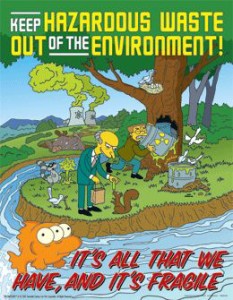A friend of mine, a hydrologist doing actual hydrology, simplified something I’ve been thinking about. He said when his work crosses over to the environmental field it’s like a vacation. There’s no charts or data to analyze. It’s simply check-the-box, compliance, and explaining. “There’s no real science anymore.” That’s the line that hit me. Although I refer to myself as an environmental scientist, I’d been thinking about how I do little actual science. Then he said it. “There’s no real science left in the environmental field.” Bam! He’s right, from a certain point of view. Is science gone from the environmental field? Continue reading
Category Archives: Environmental Questions
What Makes Hazardous Waste Hazardous?

Despite Mr. Burns worst intentions, radioactive waste is not hazardous waste. Image via SafetyPoster.com
I am asked some version of this question or need to explain it nearly every month. What makes hazardous waste hazardous? Is this hazardous waste? What’s in hazardous waste?
The answer provided here isn’t intended for an environmental professional or hazardous material manager. It is for everyone else. No regulations, no citations, and nothing technical. Actually, I know a lot of environmental professionals who don’t work in the hazmat/waste field who would benefit from this. If you want the technical definitions and regulations, you can get them here from the EPA.
I’ve found that people have a generic, catch-all perspective that hazardous waste is all the “toxic stuff we have to throw out”. It is not a generic term. It has very specific characteristics and determinations.
Q: What is hazardous waste? Continue reading
Why is Lead 5.0 mg/l?
Why is the EPA hazardous waste characteristic concentration for lead 5 mg/l or greater?
Lead is a poisonous metal and exposure to it, mainly through ingestion or inhalation, can do a long list of harm to your body – nervous system, brain, kidneys, weakness, reduced cognitive ability, and more. There’s decades of research and evidence about the toxicity of lead. That is why the EPA has determined that wastes containing a certain amount of lead are considered hazardous waste.
Let’s hear it directly from the EPA: If lead in the leaching solution is present at a concentration greater than or equal to 5 mg/l (or parts-per-million – ppm), the waste would be considered to be hazardous, and would be required to be managed as a hazardous waste.
But why 5 mg/l? Why not 100 mg/l, which is the level for barium? Why not 1 mg/l, which is cadmium? How did the EPA determine that 5 mg/l is the threshold level? That less than that leaching out of product in a landfill is not as hazardous? I could ask the same about the levels of any of the hazardous waste toxins, but lead is the one I think about.
The answer has to do with ingestion of lead from drinking water derived from groundwater or surface water sources. The maximum contaminant level (MCL) for lead in our drinking water is 50 ug/l. To determine the level for hazardous wastes, the MCL is multiplied by a 100-fold dilution attenuation factor to come up with the level of 5 mg/l. Apparently in some cases dilution is the solution to pollution.
It’s not the prettiest answer, but it is a technical question, which don’t usually have pretty answers. The summary answer is that lead is poisonous and the EPA has to set a limit that is “safe”. They have determined a level that protects the public based on history of lead poisoning, the science of the breakdown of lead, our consumption of contaminated water, and most certainly the review by policymakers and industry.
The best part is that we have identified a toxic threat to our health, taken steps to reduce our exposure, and we are a healthier, happier, and safer society due to the drastic reduction of lead. Read this for great article about how reducing lead in our environment has reduced crime.


